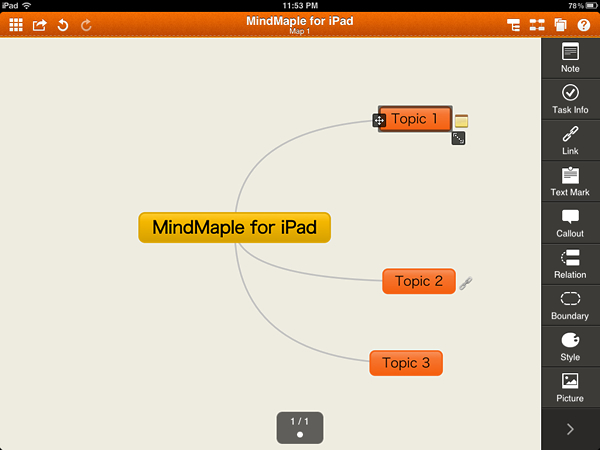
MindMaple Inc., the developer of a well-designed mind mapping program for Windows, has expanded its product line with the recent launch of an iPad app. MindMaple HD offers a well-designed user interface with an above-average number of features and excellent ease of use.
When MindMaple for Windows was introduced last year, I was impressed with how polished, stable and easy to use it was – uncommonly so for a version 1.0 product. The new iPad app continues this tradition, providing a nicely designed, intuitive user interface that makes excellent use of the iPad’s fairly large screen real estate.
A narrow menu bar across the top of the screen provides map-level commands such as returning you to the file view, exporting your maps to Dropbox or e-mail, making the map balanced and reducing the distance between topics to a minimum (compacting it) and setting the direction, theme color and background of your map, plus of course a basic help menu.
A full complement of map creation tools
What’s unusual about MindMaple HD, compared to other mind mapping apps, is that the tools for creating content are arranged in a vertical toolbar on the right side of the screen. This arrangement doesn’t get in the way as much as I thought it would, and still gives you plenty of room to work with your mind maps. It’s actually nice having more commands available to use with a single tap, rather than nested within a menu. This toolbar can be minimized to a small tab if you need more screen real estate – nice! You can tell that this app was designed specifically for the iPad, not an iPhone app that was ported to this larger platform, because of functionality like this.
MindMaple HD contains everything you’d ever want to create detailed mind maps on this popular tablet platform, including topics, notes, tasks, links, callouts, relationship lines, boundaries and images. One type of content, which MindMaple calls “text mark,” didn’t seem to work for me. I was unsure how to add one to the rudimentary mind map I created in this app. Apparently it’s supposed to allow you to add information about resources and other brief note “tags” to your topics.
To add topics to your map, you simply tap and drag your finger outward from the center of an existing topic. A fluorescent green topic shape and line spring forth beneath your finger, and follow it until you release your fingertip from the screen. The desktop version of MindMaple enabled you to do the same thing with a mouse, but here this organic method of adding topics is fully realized in the tactile environment of the iPad.
MindMaple HD enables you to format your mind map in 10 different arrangements, including left and right maps, right and left trees, org chart and split org chart. It also gives you 9 attractive color themes to choose from and a full palette of background colors.
Surprisingly, MindMaple HD supports multiple pages within a single map document – a first for a mobile mind mapping app, to the best of my knowledge.
Export options
I sent one of the mind maps I created in this app to Dropbox. The file transfer worked flawlessly, and I was able to open it using MindMaple for Windows on my laptop, with all of the content I created intact. Considering that Dropbox has grown into almost a de facto standard for cloud-based file storage, I think supporting it in this app was an excellent move on MindMaple’s part. You can also send your mind maps to yourself via e-mail in the program’s native .emm format if you don’t have a Dropbox account.
Conclusion
MindMaple HD offers an impressive number of practical features in a well-designed, easy-to-use package. It’s not just another “me-too” mind mapping app with a modicum of rudimentary capabilities, but a powerful tool that would be right at home in many business environments. According to the developer, they plan to quickly address any issues and to improve its quality and functionality. I can’t wait to see where they take it from here.
MindMaple HD is currently free and is available in the Apple AppStore.

Leave a Reply